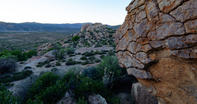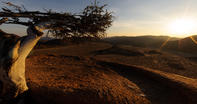Practical Housing
The basic housing unit of the Khoikhoi was a dome shaped hut called a |haru oms. These were created by building a circular framework of green branches that were stuck into the ground, bent over and tied together with thin strips of leather.

This was then covered by handmade mats made of reeds that were woven together. It was the man’s job to build the frame, while the women made the reed mats. The |haru oms were eminently practical.
The raw materials for construction were freely available across the region. In summer, the reed mats allowed air to circulate and offered shade from the hot sun. In winter, skins or extra mats were attached to the frame to keep the huts warm.
Furthermore, when it rained, the reeds swelled up to keep the water out of the huts and the round shape of the huts provided protection against strong winds. All in all, it was a rare example of form meeting function.
Suited to the Environment

The |haru oms were also portable. So, when it was time to leave, the mats were simply rolled up and carried to the next location. The frames were usually left behind to be re-used the following season. However, not every member of the family was able to participate in the annual migrations.
The very young and the elderly often stayed in permanent villages, which could include well over 100 people. These settlements also utilised |haru oms as housing, although the huts were not taken down unless they were in disrepair. In fact, the |haru oms were so suited to the environment that they were even adopted by the first white settlers who moved into the area, and remained the most common form of housing in Namaqualand until well into the 1900s. Today, the Richtersveld is the only place in the world where you still find the|haru oms.
They are used by the nomadic stock farmers who live in the Richtersveld Community Conservancy, and you can even spot a couple in the modern settlements, sitting incongruously in the yard next to neat brick houses. Admittedly, these modern examples are often supplemented by contemporary materials, such as plastic sheeting, but it is still testament to a continuous architectural tradition that stretches back many hundreds of years.
Danger of Being Forgotten
Sadly, however, the art of building the |haru oms is in danger of being forgotten and only a handful of Nama people living in the Richtersveld retain the necessary skills. But this is a form of indigenous knowledge that must be conserved and there is an ongoing effort to transfer this knowledge to new generations.
For example, recently, a group of Nama from the Richtersveld went across the border into the //Gamaseb community in Namibia to re-teach their brethren how to build these traditional reed huts. Young people in the Richtersveld are also being encouraged to learn the technique, and it is hoped that the advent of tourism and the bestowal of World Heritage status (partly because of the |haru oms) will give this programme extra impetus.
By David Fleminger